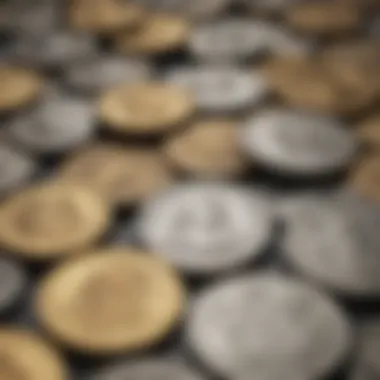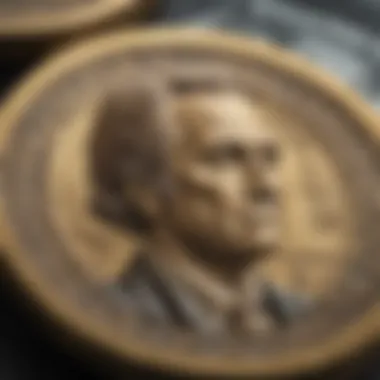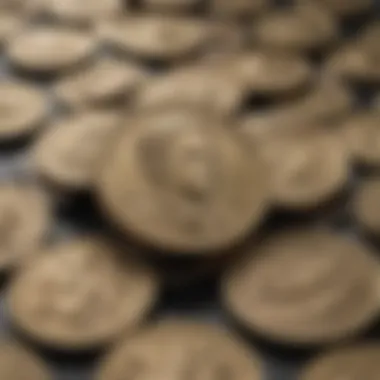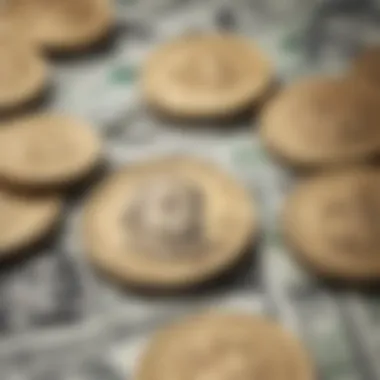Understanding the Value of U.S. Dollar Coins


Intro
Delving into the realm of U.S. dollar coins takes us on a journey rich with history, symbolism, and economic insight. While many Americans reach for paper bills without a second thought, these coins hold stories and values that extend well beyond their metallic form. From the now-rare Sacagawea coins to the more contemporary Presidential series, each coin carries a weight—a tangible connection to the nation’s past and its aspirations for the future.
As we explore the fundamentals behind U.S. dollar coins, it’s essential to grasp not just their monetary worth but also their historical context. Many view these coins as mere novelties, but they are woven into the very fabric of American history. Think back to the days when coins were the primary medium of exchange; dollar coins were often used in daily transactions, and their presence influenced commerce significantly.
In this exploration, we’ll dissect the myths surrounding dollar coins, shedding light on misconceptions that may have clouded public perception. For instance, despite what you might hear, dollar coins aren’t just for collectors or casual fans of minting; many use them in everyday life, though the acceptance in various settings varies.
This article aims to arm you with a comprehensive understanding of U.S. dollar coins. Each section will unravel key aspects—economic implications, collector interest, and what the future holds for this coinage. You'll see that understanding these coins isn’t just useful for historians or coin enthusiasts; it’s crucial for anyone invested in the intricate tapestry of the American economy.
Prologue to U.S. Dollar Coins
When it comes to currency, most people think of the familiar green bills that fit snugly in wallets and are easily exchanged for goods and services. However, U.S. dollar coins deserve a closer look for a variety of reasons. They are, quite simply, an often underappreciated component of the American monetary system. This introduction seeks to highlight the significance of these coins, emphasizing their unique attributes and roles within both economy and culture.
Definition and Characteristics
U.S. dollar coins are not just metal disks—they embody a fascinating blend of design, history, and functionality. Generally, they possess the following characteristics:
- Physical Aspects: Most dollar coins are about 26.5 mm in diameter, weighing roughly 8.1 grams. Unlike paper notes, they are durable, not easily torn or damaged, ensuring a longer lifecycle.
- Collectibility: Some dollar coins, such as the Sacagawea or the Presidential series, carry intrinsic collectible value that may far surpass their spending capacity. This collectibility arises from limited mintage or special editions.
- Design Elements: These coins often feature significant American historical figures or themes, showcasing the nation’s identity and cultural heritage. Take, for instance, the Susan B. Anthony dollar which pays tribute to the women’s suffrage movement.
These attributes make dollar coins not only practical for transactions but also valuable as historical artifacts.
Historical Overview
Delving into the history of U.S. dollar coins reveals a timeline rich with innovation, experimentations, and cultural significance. The first successful U.S. dollar coin was minted in 1794, featuring the flowing hair of Liberty. However, it wasn't until the late 19th and early 20th centuries that designs became more standardized. The Morgan dollar, struck from 1878 to 1904 and again in 1921, remains a beloved example.
Post-World War II, the introduction of the Eisenhower dollar marked a shift in design ethos to celebrate American icons. More recently, the Sacagawea dollar was introduced in 2000, aimed at promoting the use of coins in everyday transactions.
Yet the fate of the U.S. dollar coin has been rocky—fluctuating in acceptance and popularity over the decades due to public preference for paper money. While many view these coins as oddly shaped relics rather than useful currency, their historical journey showcases potential not only in utility but also in their role as a medium for telling American stories.
"The dollar coin exemplifies the intersection of commerce and culture, serving as a reminder of our nation’s journey through history."
In sum, understanding the U.S. dollar coin's definition and historical context is crucial for recognizing its importance in today’s economic landscape. They bring with them attributes worth exploring further, not merely as dollar-bill substitutes, but as significant instruments that reflect societal shifts and economic transitions.
Types of U.S. Dollar Coins
Understanding the different types of U.S. dollar coins is crucial in appreciating their role within the broader context of American currency. Each type carries its own history and significance, and recognizing these nuances allows investors, educators, and collectors alike to make informed decisions about their value and utility. The diversity of these coins illustrates not just the evolution of the monetary system, but also reflects cultural milestones and the nation’s efforts to embrace a circular economy.
Susan B. Anthony Dollar
The Susan B. Anthony dollar, introduced in 1979, stands as a testament to the progress of women's rights in the United States. This coin was designed to increase the use of dollar coins in everyday transactions, proudly featuring the face of Susan B. Anthony—a prominent suffragette.
Although it did not achieve significant circulation during its initial release, the coin remains a point of interest for collectors today. Its significance is not just in its monetary value but also as a symbol of a movement. Additionally, its design—a smaller, more lightweight coin than its predecessors—was eventually tied to public confusion with the quarter. Still, it paved the way for acceptance of dollar coins.
Sacagawea Dollar
The Sacagawea dollar, which made its debut in 2000, further embraced cultural representation in American coinage. This coin honors Sacagawea, the Native American woman who assisted Lewis and Clark during their expedition. Notably, the design showcases her carrying her infant son, which adds depth to its historical context.


The Sacagawea dollar was initially intended to boost the use of dollar coins, featuring a golden hue and a unique edge design. Over the years, it has been a favorite among collectors, and its occasional special editions, such as the "Native American" series, have kept it relevant in the market. This dollar coin serves as a reminder of the contributions of Indigenous peoples to the nation's history, and its production emphasized the importance of inclusivity in modern currency.
Presidential Dollars
Launched in 2007, the Presidential dollar series commemorates the past leaders of the United States reflecting the country's democratic foundation. Each coin features a deceased president, and the series aims to educate the public about U.S. presidential history.
However, despite the noble goal, the acceptance of these coins is somewhat lackluster due to their similarity in appearance to the Sacagawea coins. Additionally, the series has faced unique challenges in circulation, leading to debates about its effectiveness in enhancing public use of dollar coins. Even with these challenges, the coins hold significant value for collectors, highlighting a distinct era in American governance.
American Innovation Dollars
The American Innovation dollar series, introduced in 2018, represents a refreshing approach to commemorating innovation in the United States. Each coin highlights various states and territories, featuring notable contributions from local inventors and innovators. This series not only emphasizes American creativity but also introduces engaging educational components surrounding advancements in technology, science, and social change.
Collectors find these coins particularly appealing as they showcase a narrative of progress while allowing for variation with the artistic designs tailored to each state. Through the American Innovation series, these coins become more than just currency; they embody the American spirit of innovation and expansion, representing a modern take on U.S. dollar coins.
"Dollar coins are not merely tokens of trade; they encapsulate history, culture, and significant milestones in American society."
In summary, each type of U.S. dollar coin brings its flavor to the table, enriching the narrative of American currency while inviting diverse perspectives on value and acceptance in daily life.
Economic Impact of Dollar Coins
Dollar coins may not always take the spotlight in discussions about U.S. currency, but their economic implications are worth considerable attention. Analyzing the economic impact of dollar coins opens a window into their production costs, their practical use in everyday transactions, and the broader impression they leave on the economy. This section breaks down the value these coins provide to various sectors, from the minting process to cash flow in the marketplace.
Cost of Production versus Value
When you put a dollar coin under the microscope, one critical element is its production cost. It might come as a surprise, but producing coins can be a hefty undertaking. With each coin costing more than its face value due to materials and minting processes, it raises the question of their overall economic utility. For instance, a Susan B. Anthony dollar coin might appear simply as a piece of metal that’s worth a buck, but the minting expense often fluctuates based on market prices for raw materials like copper, nickel, and zinc.
"The striking cost of producing coins can dampen their value in circulation and influence decisions by both the government and the public."
A consistent point of contention is the trade-off between producing metal coins and paper currency. While a paper dollar's production cost is less than fifty cents, a single dollar coin can swing close to a dollar or even more during certain fiscal years.
On another note, despite these costs, dollar coins do offer durability. They typically last much longer in circulation than their paper counterparts. The long-term investment in dollar coins can pay off as they require less frequent replacement. When you think about it, a sturdy coin could be more economical in the grand scheme of things, reducing ongoing costs for the Federal Reserve.
Impact on Cash Flow within the Economy
The cash flow dynamics in the economy are another area where dollar coins make their mark. When people think about using coins versus notes, they often overlook how coins can affect liquidity. The presence of dollar coins can contribute positively to the cash flow by facilitating more efficient transactions. Imagine a retail environment where cash transfers occur more smoothly—dollar coins can bolster quick exchanges, thus improving the customer experience.
In addition, greater deployment of these coins can lead to reduced dependency on paper currency. This reshaping of cash flow can help streamline transactions at various levels of the economy: from a small coffee shop to large chain retailers. With reduced production needs for paper money, the costs associated with printing can dwindle.
On the other hand, skepticism about using dollar coins remains in the general public, leading to a laborious acceptance rate. Many people in everyday spending might still prefer bills due to familiar habits or convenience, which can hamper the full potential of dollar coins in circulation. Consumers may equate the stability of paper money with security, which in turn alters how they interact with alternative forms of currency.
Collector Market Dynamics
The realm of U.S. dollar coins is not just about currency; it weaves a rich tapestry of history, investment, and passion. The market dynamics for dollar coins present an intriguing perspective that varies widely among collectors. This section uncovers the layers behind collector interests and market trends, providing key insights into why these coins are much more than mere metal.
Collector Interest and Motivations
When we think of collectors, we often picture individuals scouring flea markets or engaging in spirited discussions at coin shows. The motivations for collecting U.S. dollar coins can be as varied as the coins themselves. Some collectors are drawn to the historical narratives embedded within each piece. The Susan B. Anthony dollar, for example, not only symbolizes women's rights but is also a reflection of the societal changes during its minting era.


Others may focus on the artistry and craftsmanship of the coins. The Sacagawea Dollar is not just a currency; it's a representation of indigenous contributions and American history. Collectors find an allure in owning a piece of this heritage, often seeking coins in pristine condition, known as ‘uncirculated’ or those with errors that may pique their curiosity, such as the infamous mule errors.
Additionally, the financial aspect cannot be ignored. Investors eye the potential for appreciation in value, especially when engaging with rare variants or limited editions like the American Innovation Dollars. It's not uncommon for a collector to consider both the hobby and the financial implications, making informed decisions based on market trends.
Market Trends and Valuation
The collector market for U.S. dollar coins is influenced by various trends that dictate valuation and desirability. An important factor is the rarity of certain coins. The older dollars, especially those minted in lower quantities, are often at the top of collectors' lists. For instance, the 1804 silver dollar is viewed as one of the most coveted in American numismatic history, fetching prices that can reach several million dollars.
Furthermore, external economic conditions can sculpt collector behavior. During economic downturns, collectors may pivot, opting for more affordable coins, which increases competition for less expensive items. This shift leads to a market where collectors can find hidden gems at flea markets or online auction sites. Regular platforms like eBay and Reddit's various coin collector forums serve as marketplaces where enthusiasts engage in buying, selling, and trading.
Another trend is the technological impact. Digital resources, such as NGC's and PCGS's databases, allow collectors to authenticate coins, check their grades, and keep abreast of current values. These tools provide a wealth of information that aids collectors in making educated decisions, effectively mapping the fluctuations in coin valuation.
"A coin is not just a piece of metal. It embodies stories of lives, economies, and values etched in its design."
Whether you are a seasoned numismatist or just venturing into this world, engaging with the nuances of the collector community can greatly enrich your experience in this unique field.
Misconceptions Surrounding Dollar Coins
Understanding the misconceptions surrounding U.S. dollar coins is crucial for grasping their overall value and significance in the economy. Many people harbor misunderstandings that affect their willingness to accept, collect, or utilize these coins. These misconceptions often stem from lack of familiarity or outdated information, leading to a persistent bias in favor of paper currency. By addressing these beliefs, we can improve public perception and foster greater acceptance of dollar coins in daily transactions.
Public Perception and Acceptance
The public's perception of dollar coins has historically been colored by a mixture of sentiments, ranging from indifference to outright aversion. For example, many folks erroneously believe that dollar coins are cumbersome or inconvenient compared to paper bills. This notion might come from individuals who experienced the Susan B. Anthony dollar in the late 20th century, which faced significant resistance. It was often confused with the quarter, causing a general reluctance to use it.
Some barriers to acceptance are rooted in psychological factors. Models of behavior suggest customers feel more comfortable dealing with paper money; it’s swift and, in many ways, easier to handle. A study conducted by the U.S. Mint highlighted that significant numbers of the population still prefer paper wallets. Further, many believe that dollar coins are less personal compared to notes, which commonly feature historic figures and hold a certain nostalgic value.
"Most people really don’t see the value of having to fish for a coin when a dollar bill is just a flap away."
Marketing Strategies: To counteract this, U.S. authorities could take several steps to boost public acceptance:
- Awareness Campaigns: Educating the public about the advantages of dollar coins, such as their durability and cost-effectiveness compared to paper currency, can reshape negative attitudes.
- Incentives Programs: Encouraging retailers to provide dollar coins as change might increase exposure and gradually improve their acceptance over time.
Collective social habits can shift; if we can make dollar coins a staple in everyday transactions, acceptance may also follow suit.
Comparison with Paper Currency
When comparing dollar coins to paper currency, the differences extend beyond physical characteristics. Dollar coins present certain practical benefits that can often be overlooked.
- Durability: Dollar coins are made of metal and last significantly longer than paper currency, which wears out and must be replaced frequently.
- Cost of Production: While it may seem counterintuitive, producing dollar coins can be cheaper over the long haul. Despite higher initial manufacturing costs compared to paper bills, their longevity can lead to cost savings in the future.
- Inflation Resistance: The intrinsic value of dollar coins could be less subject to inflation swings compared to paper, securing their worth more effectively over time.
On the flip side, paper currency benefits from wide familiarity and established behaviors. Most transactions occur with cash, wherein bills are just easier to use in day-to-day exchanges. While they might be heavy in pockets, they remain a reliable form of currency.
Acceptance and Utilization
The acceptance and utilization of U.S. dollar coins are pivotal in understanding their overall value and relevance. This section aims to shed light on crucial aspects of how these coins are perceived in both retail environments and governmental frameworks. By diving into the specific challenges faced in retail acceptance and examining government usage programs, we can paint a clearer picture of the landscape surrounding dollar coins today.
Retail Acceptance Challenges


When it comes to retail acceptance, U.S. dollar coins face a myriad of obstacles. First and foremost, the general public's familiarity with paper currency significantly overshadows the coin alternatives. Many businesses still prefer using bills due to the ease of giving change. This preference poses a challenge for the expansion of dollar coins into everyday transactions.
Moreover, there’s a gap in public awareness. Many folks are simply unaware of the existence and use of these coins. It's akin to trying to find a needle in a haystack; if customers aren’t carrying dollar coins, they won’t ask for them, and retailers won’t stock them. This circle can create a feedback loop that is hard to break.
- Consumer Hesitance: Some individuals are often reluctant to use coins that might imply an outdated currency system. This perception impacts even the most earnest efforts to promote dollar coins for spending.
- Merchant Limitations: Small businesses might lack the resources to handle coinage effectively. Their systems may not be designed to accommodate bulky coins, especially when it comes to cash registers that prioritize paper.
"The dollar coin, once the go-to for everyday purchases, faces more hurdles today than a marathon runner on a cold morning."
Given these factors, enhancing the retail acceptance of dollar coins necessitates a concerted effort. Retailers and advocacy groups might need to cultivate awareness through education campaigns. For instance, promotional events in which consumers can see the coins in action can be beneficial. Moreover, tackling the stigma around their use holds the key.*
Government Usage and Programs
In terms of government utilization, there are programs designed to boost the circulation of dollar coins. Initiated by various regulations, these efforts mainly focus on integrating dollar coins within governmental operations, keeping in mind benefits like durability and lower production costs compared to paper currency.
One significant program is the U.S. Mint's efforts to issue new dollar coins regularly. The mint produces these coins with a varied range of designs, which not only pay homage to historical figures but also aim to attract interest from collectors and the general public alike.
- Federal Agencies: Some agencies leverage dollar coins for transactions, particularly in instances where denominations are beneficial for bulk purchases. When agency budgets necessitate acquiring items, dollar coins help manage spending more efficiently.
- Public Transportation: Some states have adopted the use of dollar coins in public transit systems. For example, San Francisco's Bay Area Rapid Transit (BART) has used them in fare collection systems. These efforts garner much-needed visibility, shaping public behavior towards acceptance.
While there are programs aimed at promoting the use of dollar coins, their effectiveness often hinges on broader acceptance within society. Making dollar coins a more frequent sight at retail outlets could back their continuous production and circulation. The government’s role is just as crucial as that of the taxpayers' willingness to adapt their habits. Achieving a harmonious relationship between the two is key for enhancing the dollar coin's place in 21st-century commerce.
Future of U.S. Dollar Coins
The future of U.S. dollar coins deserves attention as it holds significant implications for the economy, collectors, and the general public. Not only do they represent an alternative to dollar bills, but their potential developments could reshape perceptions and usage in everyday transactions. Whether you're a collector eager to see new releases or an investor considering market trends, understanding the future trajectory of these coins is essential.
Potential for New Releases
The possibility of new coin designs and series coming up is both an exciting and vital facet of the dollar coin landscape. Over the years, the U.S. Mint has occasionally introduced coins to celebrate various themes, including historical figures and events. For instance, the series honoring the American Innovation continues this trend, showcasing individuals who have made impactful contributions.
- Innovative Designs: New releases could incorporate modern artistic trends or even interactive features that engage younger generations. For example, imagine a physical coin that resonates with augmented reality apps, allowing new educational avenues.
- Cultural Representation: Future series might also focus on more extensive cultural inclusivity, telling stories from diverse communities. This can appeal to more collectors and evoke stronger connections with the public.
- Sustainability Initiatives: As environmental awareness increases, a focus on sustainable materials for coin production could shape new designs and attract attention from eco-conscious collectors.
Engaging the public with fresh ideas and themes increases the chances that dollar coins become more favorable in transactions and among collectors.
Long-term Market Outlook
The long-term market outlook for dollar coins hinges on a few key factors. While the face value is straightforward, the underlying valuation is a bit more intricate, shaped by demand, rarity, and shifts in economic trends.
- Economic Shifts: With rising inflation, a transition toward more coinage may occur as consumers seek alternatives to paper money. The adoption of dollar coins in more venues could drive lower demand for paper currency.
- Collector Value: For the seasoned collector, certain coins appreciate significantly, depending on their rarity and condition. Tracking market demand for specific series and studying previous sales patterns could prove valuable in making investment decisions.
- Institutional Support: The role of government support in promoting dollar coins can’t be understated. Should there be robust backing for dollar coin usage in federal transactions, it may create a snowball effect, leading to broader acceptance in retail.
“As we tread into the future, the balance will be between innovation and tradition, possibly leading dollar coins to a renaissance unseen in decades.”
The End
The importance of understanding the value of U.S. dollar coins lies in its multifaceted implications for both collectors and everyday users. As the article highlights, these coins are not merely a relic of past monetary trends but hold significant status in the current economic landscape. They offer insights into historical contexts, economic impacts, and consumer behaviors. Furthermore, recognizing their value is crucial for investors seeking alternative assets, as well as for educators looking to impart lessons on monetary policy.
Recap of Key Points
As we have explored throughout this piece, several key points emerge:
- Historical Significance: U.S. dollar coins carry rich histories that reflect the evolution of the American economy.
- Economic Impact: The cost of production versus their intrinsic value can influence broader monetary policies and cash flow.
- Collector Dynamics: The interest in these coins drives a vibrant collector market, informing their valuation and desirability.
- Acceptance challenges: Despite their benefits, dollar coins face hurdles in acceptance among retailers and consumers.
- Future Potential: Looking ahead, new releases and market trends suggest evolving opportunities for these coins.
Final Thoughts on Value and Relevance
"The more you know about the currency you use, the more empowered you become to make informed financial choices."
Through dishes like the American Innovation Dollar, or the iconic Susan B. Anthony Dollar, dollar coins encapsulate a broader narrative about values, decisions, and economic principles that shape our lives today.







